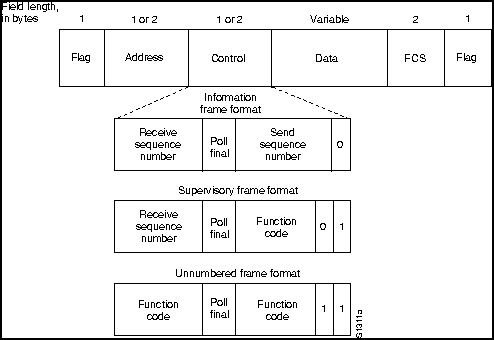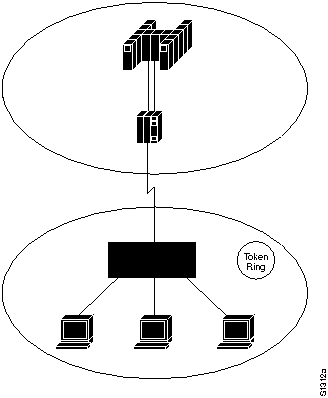|
|
Synchronous Data Link Control
and Derivatives
IBM developed the Synchronous Data Link Control (SDLC) protocol in the mid-1970s for use in Systems Network Architecture (SNA) environments. SDLC was the first of an important new breed of link-layer protocols based on synchronous, bit-oriented operation. Compared to synchronous character-oriented (for example, Bisync from IBM) and synchronous byte-count-oriented protocols (for example, Digital Data Communications Message Protocol (DDCMP) from Digital Equipment Corporation), bit-oriented synchronous protocols are more efficient, more flexible, and often faster.
After developing SDLC, IBM submitted it to various standards committees. The International Organization for Standardization (ISO) modified SDLC to create the High-Level Data Link Control (HDLC) protocol. The International Telecommunication Union Telecommunication Standardization Sector (ITU-T) (formerly CCITT) subsequently modified HDLC to create Link Access Procedure (LAP), and then Link Access Procedure, Balanced (LAPB). The Institute of Electrical and Electronic Engineers (IEEE) modified HDLC to create IEEE 802.2. Each of these protocols has become important in its own domain. SDLC remains the primary SNA link-layer protocol for wide-area network (WAN) links.
SDLC supports a variety of link types and topologies. It can be used with point-to-point and multipoint links, bounded and unbounded media, half-duplex and full-duplex transmission facilities, and circuit-switched and packet-switched networks.
SDLC identifies two types of network nodes:
SDLC primaries and secondaries can be connected in four basic configurations:
The SDLC frame appears in Figure 11-1.
Figure 11-1 : SDLC Frame Format

As the figure shows, SDLC frames are bounded by a unique flag pattern. The address field always contains the address of the secondary involved in the current communication. Because the primary is either the communication source or destination, there is no need to include the address of the primary---it is already known by all secondaries.
The control field uses three different formats, depending on the type of SDLC frame used. The three SDLC frames are described as follows:
The frame check sequence (FCS) precedes the ending flag delimiter. The FCS is usually a cyclic redundancy check (CRC) calculation remainder. The CRC calculation is redone in the receiver. If the result differs from the value in the sender's frame, an error is assumed.
A typical SDLC-based network configuration appears in Figure 11-2. As illustrated, an IBM establishment controller (formerly called a cluster controller) in a remote site connects to dumb terminals and to a Token Ring network. In a local site, an IBM host connects (via channel-attached techniques) to an IBM front-end processor (FEP), which can also have links to local Token Ring local-area networks (LANs) and an SNA backbone. The two sites are connected through an SDLC-based 56-kbps leased line.
Figure 11-2 : Typical SDLC-Based Network Configuration

Despite the fact that it omits several features used in SDLC, HDLC is generally considered to be a compatible superset of SDLC. LAP is a subset of HDLC. LAPB was created to ensure ongoing compatibility with HDLC, which had been modified in the early 1980s. IEEE 802.2 is a modification of HDLC for LAN environments. Qualified Logical Link Control (QLLC) is a link-layer protocol defined by IBM that allows SNA data to be transported across X.25 networks.
HDLC shares the frame format of SDLC, and HDLC fields provide the same functionality as those in SDLC. Also, like SDLC, HDLC supports synchronous, full-duplex operation.
HDLC differs from SDLC in several minor ways. First, HDLC has an option for a 32-bit checksum. And, unlike SDLC, HDLC does not support the loop or hub go-ahead configurations.
The major difference between HDLC and SDLC is that SDLC supports only one transfer mode, while HDLC supports three. The three HDLC transfer modes are as follows:
LAPB is best known for its presence in the X.25 protocol stack. LAPB shares the same frame format, frame types, and field functions as SDLC and HDLC. Unlike either of these, however, LAPB is restricted to the ABM transfer mode, and so is appropriate only for combined stations. Also, LAPB circuits can be established by either the data terminal equipment (DTE) or the data circuit-terminating equipment (DCE). The station initiating the call is determined to be the primary, while the responding station is the secondary. Finally, LAPB use of the P/F bit is somewhat different from that of the other protocols. For details on LAPB, see Chapter 12, "X.25."
IEEE 802.2 is often referred to as Logical Link Control (LLC). It is extremely popular in LAN environments, where it interoperates with protocols such as IEEE 802.3, IEEE 802.4, and IEEE 802.5.
IEEE 802.2 offers three types of service. Type 1 provides unacknowledged connectionless service. Type 2 provides connection-oriented service. Type 3 provides acknowledged connectionless service.
As an unacknowledged connectionless service, LLC Type 1 does not confirm data transfers. Because many upper-layer protocols such as Transmission Control Protocol/Internet Protocol (TCP/IP) offer reliable data transfer that can compensate for unreliable lower-layer protocols, Type 1 is a commonly used service.
LLC Type 2 (often called LLC2) service establishes logical connections between sender and receiver, and is therefore connection-oriented. LLC2 acknowledges data upon receipt and is found in IBM communication systems.
Although LLC Type 3 service supports acknowledged data transfer, it does not establish logical connections. As a compromise between the other two LLC services, LLC Type 3 is useful in factory automation environments where error detection is important, but context storage space (for virtual circuits) is extremely limited.
End stations can support multiple LLC service types. A Class I device supports only Type 1 service. A Class II device supports both Type 1 and Type 2 service. Class III devices support both Type 1 and Type 3 service, while Class IV devices support all three types of service.
Upper-layer processes use IEEE 802.2 services through service access points (SAPs). The IEEE 802.2 header begins with a destination service access point (DSAP) field, which identifies the receiving upper-layer process. In other words, after the receiving node's IEEE 802.2 implementation completes its processing, the upper-layer process identified in the DSAP field receives the remaining data. Following the DSAP address is the source service access point (SSAP) address, which identifies the sending upper-layer process.
QLLC provides the data link control capabilities that are required to transport SNA data across X.25 networks. Together, QLLC and X.25 replace SDLC in the SNA protocol stack.
QLLC uses the packet-level layer (Layer 3) of the X.25 protocol stack. To indicate that a Layer 3 X.25 packet must be handled by QLLC, a special bit, called the qualifier bit, in the general format identifier (GFI) of the Layer 3 X.25 packet-level header is set to one. The SNA data is carried as user data in Layer 3 X.25 packets.
For more information about the X.25 protocol stack, see Chapter 12, "X.25."
|
|
Copyright 1988-1996 © Cisco Systems Inc.